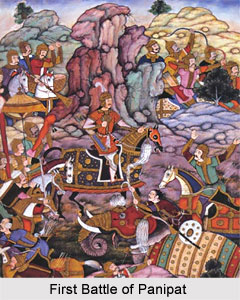 First Battle of Panipat took place between Babur and Sultan Ibrahim Lodi. It was fought in the year 1526 A.D. at Panipat, few miles away from Delhi. It marked the beginning of the Mughal Empire. This was one of the earliest battles involving gunpowder firearms and field artillery.
First Battle of Panipat took place between Babur and Sultan Ibrahim Lodi. It was fought in the year 1526 A.D. at Panipat, few miles away from Delhi. It marked the beginning of the Mughal Empire. This was one of the earliest battles involving gunpowder firearms and field artillery.
Strategies of First Battle of Panipat
Babur"s forces consisted of 15,000 men and had only 15 to 20 pieces of field artillery. Lodi had one lakh men along with hundred war elephants. However Babur scored over Lodi because he had guns which he used to scare the elephants away. The scared elephants trampled Lodi"s own men. For about a week, both the armies faced each other and engaged in skirmishes. The real battle started on the morning of 21st April 1526 A.D. and by noon it was over.
The weapons, the Tulghuma method of warfare and superior generalship of Babur, on the one hand, and the weaknesses of Ibrahim Lodi, on the other hand, were responsible for the success of Babur in this battle. Babur was experienced and a more capable commander than Ibrahim whom he described in his Memoirs as "an inexperienced young man careless in his movements, who marched without order, halted or retired without method, and engaged without foresight". Babur had fine artillery, a more effective mobile cavalry and he used better war-tactics while Ibrahim had no artillery and fought in a traditional way depending on his war-elephants which having no experience of facing fire-arms and destroyed their own army in panic. Ibrahim"s army was not well-organised. He had lost the sympathy of the Afghan-nobility as well as the loyalty of his subjects. Mostly his army consisted of hastily collected mercenary soldiers. Therefore, though the Afghans fought bravely, they proved no match to the well-trained army of Babur. Ibrahim Lodi was lay dead on the field and his army was destroyed. Ibrahim Lodi was abandoned by his vassals and generals. It marked the reign of the Mughals in India. The first battle of Panipat was significant in a way because it was one of the earliest battles which involved the use of gunpowder firearms and field artillery.
It is generally held that Babur"s guns proved decisive in battle, firstly because Ibrahim Lodi lacked any field artillery, but also because the sound of the cannon frightened Lodi"s elephants, causing them to trample Lodi"s own men. It was the tactics which helped in winning the day.
Result of First Battle of Panipat
The results of the battle of Panipat sealed the fate of Lodi dynasty in India. It was wiped out of Indian politics. The power of the Afghans was weakened in India though not completely destroyed. Babur soon occupied Delhi and Agra and thus laid down the foundation of the rule of the Mughal dynasty in India though he had yet to fight more battles to safeguard his claim over his Indian possessions.



















